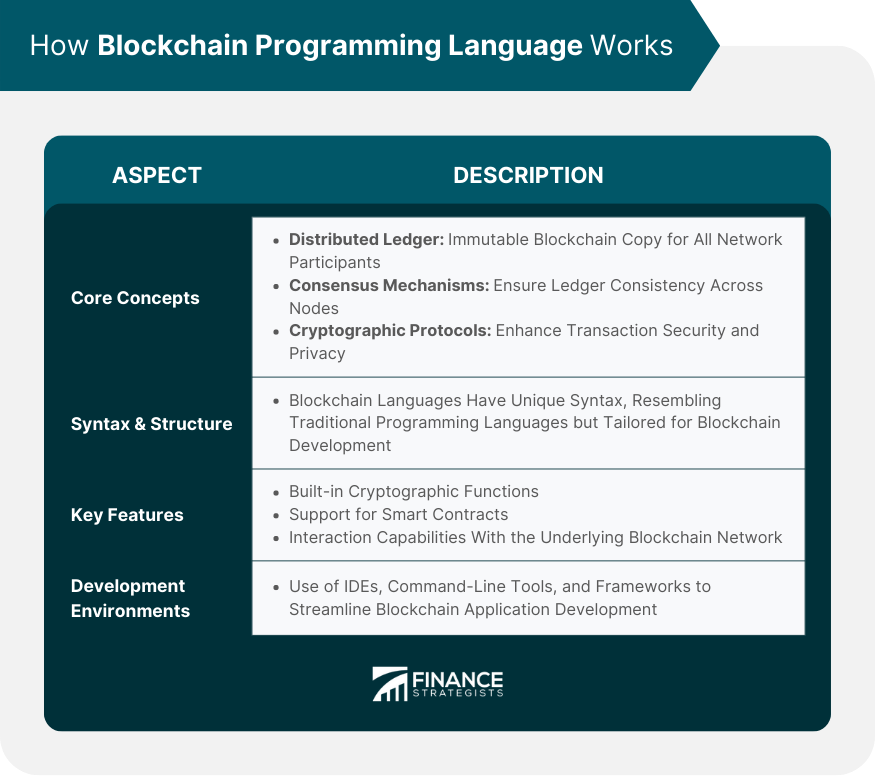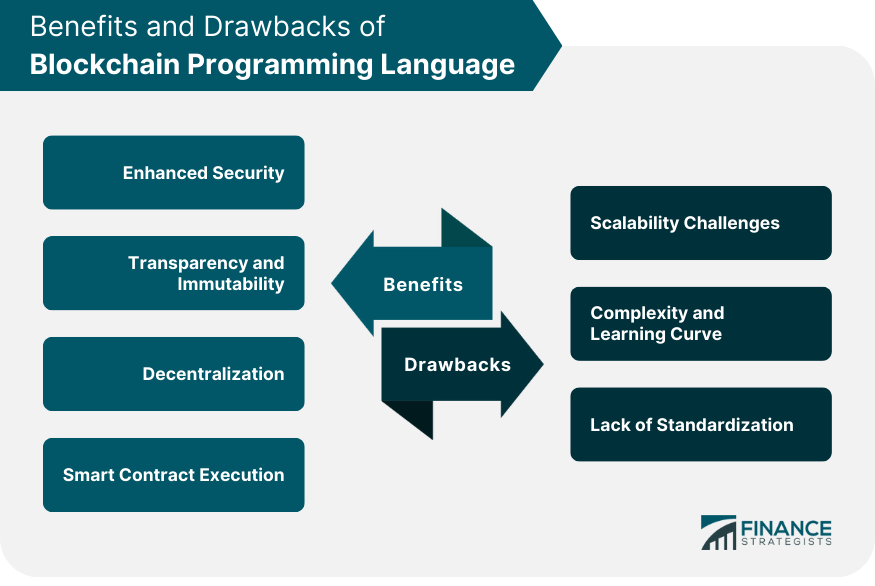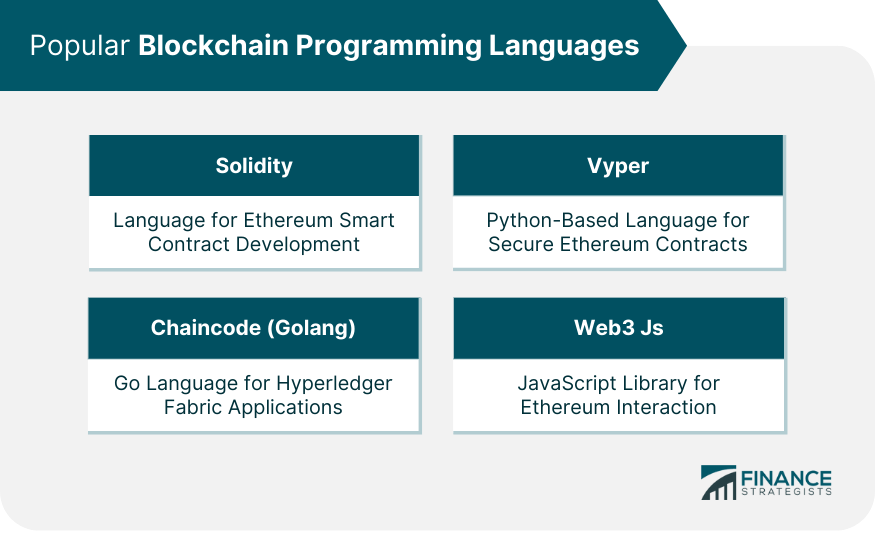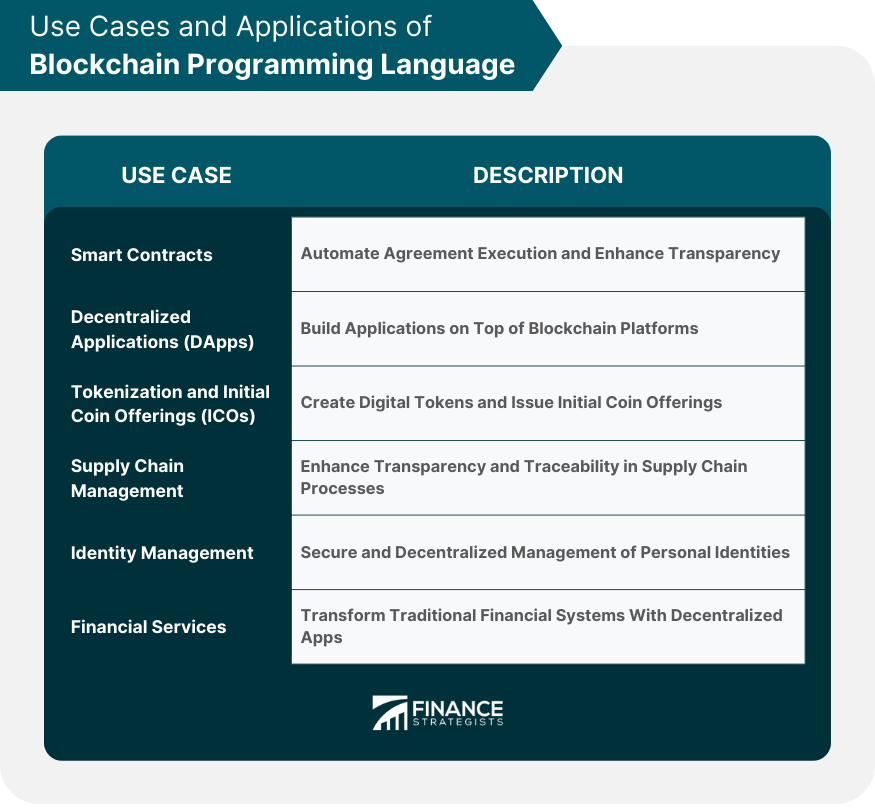Blockchain programming language refers to a specialized set of coding languages designed for developing applications and smart contracts on blockchain platforms. These languages provide developers with the necessary tools and syntax to create decentralized and secure applications that leverage the potential of blockchain technology. By using blockchain programming languages, developers can interact with blockchain networks, write smart contracts, and build various decentralized applications (DApps) that operate on top of blockchain platforms. These languages enable the execution of self-executing agreements with predefined conditions, automating processes and eliminating the need for intermediaries. Furthermore, common examples of blockchain programming languages include Solidity for Ethereum, JavaScript for Lisk, and C++ for Bitcoin, each tailored to the specific needs and characteristics of their respective platforms. To understand how the blockchain programming language works, it is important to grasp the core concepts, syntax, structure, and key features that underpin these languages. Let's explore these aspects in more detail. Blockchain programming languages operate on the fundamental concepts of blockchain technology. Distributed Ledger: The distributed ledger is a key aspect of blockchain, where all network participants have an immutable copy of the entire blockchain. Blockchain programming languages help create and manage these ledgers. Consensus Mechanisms: Consensus mechanisms like Proof of Work or Proof of Stake maintain ledger consistency across nodes, with blockchain programming languages implementing these in the network. Cryptographic Protocols: Cryptography ensures the security and privacy of blockchain transactions, with blockchain programming languages incorporating these protocols. By understanding these principles, developers can effectively utilize blockchain programming languages. Blockchain programming languages possess their unique syntax and structure, which may vary depending on the specific language used. However, they generally resemble traditional programming languages with additional features and libraries designed for blockchain development. Blockchain programming languages offer key features that facilitate the development of secure and decentralized applications. These features include built-in cryptographic functions, support for smart contracts, and interaction with the underlying blockchain network. These capabilities empower developers to create robust and tamper-proof applications. Developers employ specialized development environments to write, test, and deploy blockchain applications. These environments include integrated development environments (IDEs), command-line tools, and frameworks that streamline the development process. These tools provide a comprehensive ecosystem for blockchain application development. Blockchain programming languages provide several benefits that contribute to the widespread adoption of blockchain technology. One of the key benefits of blockchain programming languages is enhanced security. By leveraging cryptographic protocols and smart contract execution, these languages help prevent fraud, tampering, and unauthorized access to data. This inherent security feature ensures the integrity and confidentiality of transactions and information stored on the blockchain. Blockchain programming languages enable the development of applications that leverage the transparency and immutability of blockchain networks. The decentralized nature of blockchain ensures that all transactions and data recorded on the blockchain are transparent, tamper-resistant, and auditable. This transparency fosters trust and accountability in various industries. Decentralization is a fundamental aspect of blockchain programming languages. These languages allow developers to create decentralized applications that operate without relying on a central authority. By distributing data and computation across a network of nodes, decentralized applications enhance resilience, eliminate single points of failure, and promote democratization. Blockchain programming languages, such as Solidity and Vyper, enable the creation and deployment of smart contracts on blockchain platforms. Smart contracts are self-executing agreements with predefined conditions. These contracts automate processes, eliminate intermediaries, and ensure the secure and reliable execution of agreements between parties. While blockchain programming languages offer numerous benefits, they also come with certain drawbacks and challenges that developers should be aware of. One of the prominent challenges faced by blockchain programming languages is scalability. Blockchain networks, especially public ones, often struggle with limited transaction throughput and high latency. As the volume of transactions increases, scaling blockchain applications becomes a complex task. Efforts are being made to address this issue through solutions like sharding and layer-two scaling. Blockchain programming languages can be complex to learn and master. Developers need to understand the underlying blockchain technology, cryptographic principles, and the specific language syntax and libraries. This learning curve can pose challenges, particularly for newcomers entering the field. However, with practice and dedication, developers can overcome these hurdles. The lack of standardization in blockchain programming languages across different blockchain platforms presents a challenge for developers. Each blockchain ecosystem may have its own set of programming languages and frameworks. This fragmentation makes it difficult to transfer skills and code between different platforms and hampers interoperability. Standardization efforts are underway to address this issue. Various blockchain programming languages have gained popularity due to their compatibility with specific blockchain platforms and their extensive community support. Here are some widely used blockchain programming languages: Solidity is a popular programming language for developing smart contracts on the Ethereum blockchain. It has a syntax similar to JavaScript, making it accessible to developers familiar with web development. Solidity offers extensive documentation and a wide range of tools and libraries for Ethereum-based development. Vyper is a Python-based programming language designed for writing secure and readable smart contracts on the Ethereum platform. It emphasizes simplicity and security by restricting certain features found in Solidity. Vyper's focus on readability and security reduces the risk of vulnerabilities in smart contracts. Chaincode, also known as Smart Contract in the Go language, is used for developing applications on the Hyperledger Fabric blockchain platform. Golang's simplicity and efficiency make it suitable for enterprise-grade applications that require high-performance and scalability. Web3.js is a JavaScript library that simplifies the interaction with Ethereum-based smart contracts and blockchain networks. It provides an easy-to-use API for developers to interact with the Ethereum Virtual Machine (EVM) and build decentralized applications using JavaScript. Blockchain programming languages have found diverse applications across various industries. Smart contracts, enabled by blockchain programming languages, revolutionize industries by automating agreement execution. They find applications in supply chain management, financial services, insurance, and decentralized finance (DeFi). Smart contracts enhance transparency, reduce costs, and enable trustless interactions between parties. Blockchain programming languages empower the development of decentralized applications (DApps) that operate on top of blockchain platforms. DApps provide services like decentralized exchanges, gaming platforms, voting systems, and digital identity management. These applications leverage blockchain's decentralized nature to offer transparency and user control. Blockchain programming languages facilitate the tokenization of assets, allowing the creation and management of digital tokens representing real-world assets. Initial Coin Offerings (ICOs) and Security Token Offerings (STOs) utilize smart contracts to issue and distribute tokens, democratizing access to investment opportunities. Blockchain programming languages have seen significant adoption in supply chain management systems. By leveraging blockchain's transparency and immutability, developers create applications that track and trace goods, verify authenticity, and streamline logistics processes. These applications enhance transparency, reduce counterfeiting, and improve supply chain efficiency. Blockchain programming languages contribute to secure and decentralized identity management systems. These systems enable individuals to maintain control over their personal data while granting selective access to verified entities. Blockchain-based identity management enhances privacy, reduces the risk of identity theft, and eliminates the need for intermediaries. Blockchain programming languages play a vital role in transforming traditional financial services. They enable the development of decentralized financial applications, including lending platforms, decentralized exchanges (DEXs), stablecoins, and asset management solutions. These applications offer transparency, reduce costs, and enhance financial inclusivity. Blockchain programming languages offer a powerful toolkit for developers to build decentralized applications and smart contracts on blockchain platforms. These languages provide enhanced security, transparency, and decentralization, enabling the creation of tamper-proof and trustworthy applications. While blockchain programming languages present challenges like scalability, complexity, and lack of standardization, ongoing research and development efforts aim to address these issues and improve the overall ecosystem. Popular blockchain programming languages such as Solidity, Vyper, Chaincode (Golang), and Web3.js have gained traction and offer extensive resources and community support. These languages empower developers to leverage the potential of blockchain technology and explore various use cases in industries such as supply chain management, finance, and identity management. Developers who embrace blockchain programming languages can contribute to the decentralized economy, shape the future of finance, and drive innovation in various sectors.What Is a Blockchain Programming Language?
How Blockchain Programming Language Works
Core Concepts
Syntax and Structure
Key Features
Development Environments

Benefits of Blockchain Programming Language
Enhanced Security
Transparency and Immutability
Decentralization
Smart Contract Execution
Drawbacks of Blockchain Programming Language
Scalability Challenges
Complexity and Learning Curve
Lack of Standardization

Popular Blockchain Programming Languages
Solidity
Vyper
Chaincode (Golang)
Web3.js

Use Cases and Applications of Blockchain Programming Language
Smart Contracts
Decentralized Applications (DApps)
Tokenization and Initial Coin Offerings (ICOs)
Supply Chain Management
Identity Management
Financial Services

Final Thoughts
Blockchain Programming Language FAQs
Blockchain programming languages are specialized coding languages for developing applications and smart contracts on blockchain platforms.
Blockchain programming languages offer enhanced security, transparency, and decentralization, and enable smart contract execution.
Popular blockchain programming languages include Solidity, Vyper, Chaincode (Golang), Web3.js, and others.
Use cases include smart contracts, decentralized applications (DApps), tokenization, supply chain management, identity management, and financial services.
Challenges include scalability issues, complexity, and lack of standardization across different blockchain platforms.
True Tamplin is a published author, public speaker, CEO of UpDigital, and founder of Finance Strategists.
True is a Certified Educator in Personal Finance (CEPF®), author of The Handy Financial Ratios Guide, a member of the Society for Advancing Business Editing and Writing, contributes to his financial education site, Finance Strategists, and has spoken to various financial communities such as the CFA Institute, as well as university students like his Alma mater, Biola University, where he received a bachelor of science in business and data analytics.
To learn more about True, visit his personal website or view his author profiles on Amazon, Nasdaq and Forbes.











